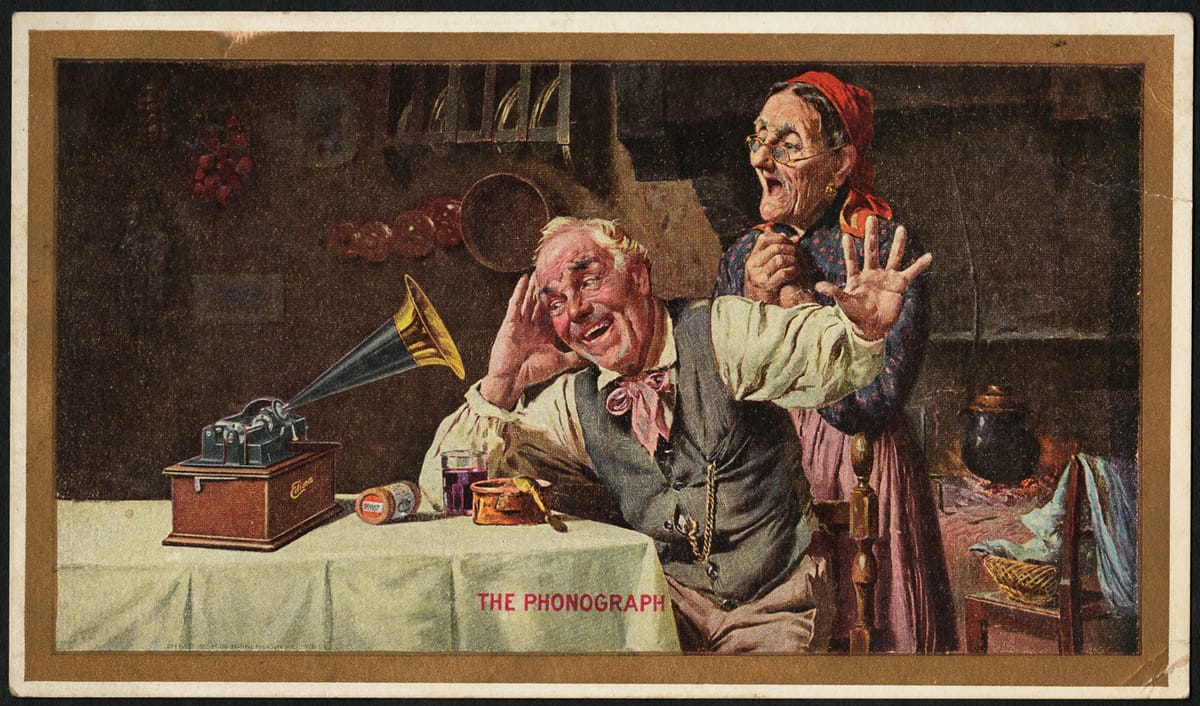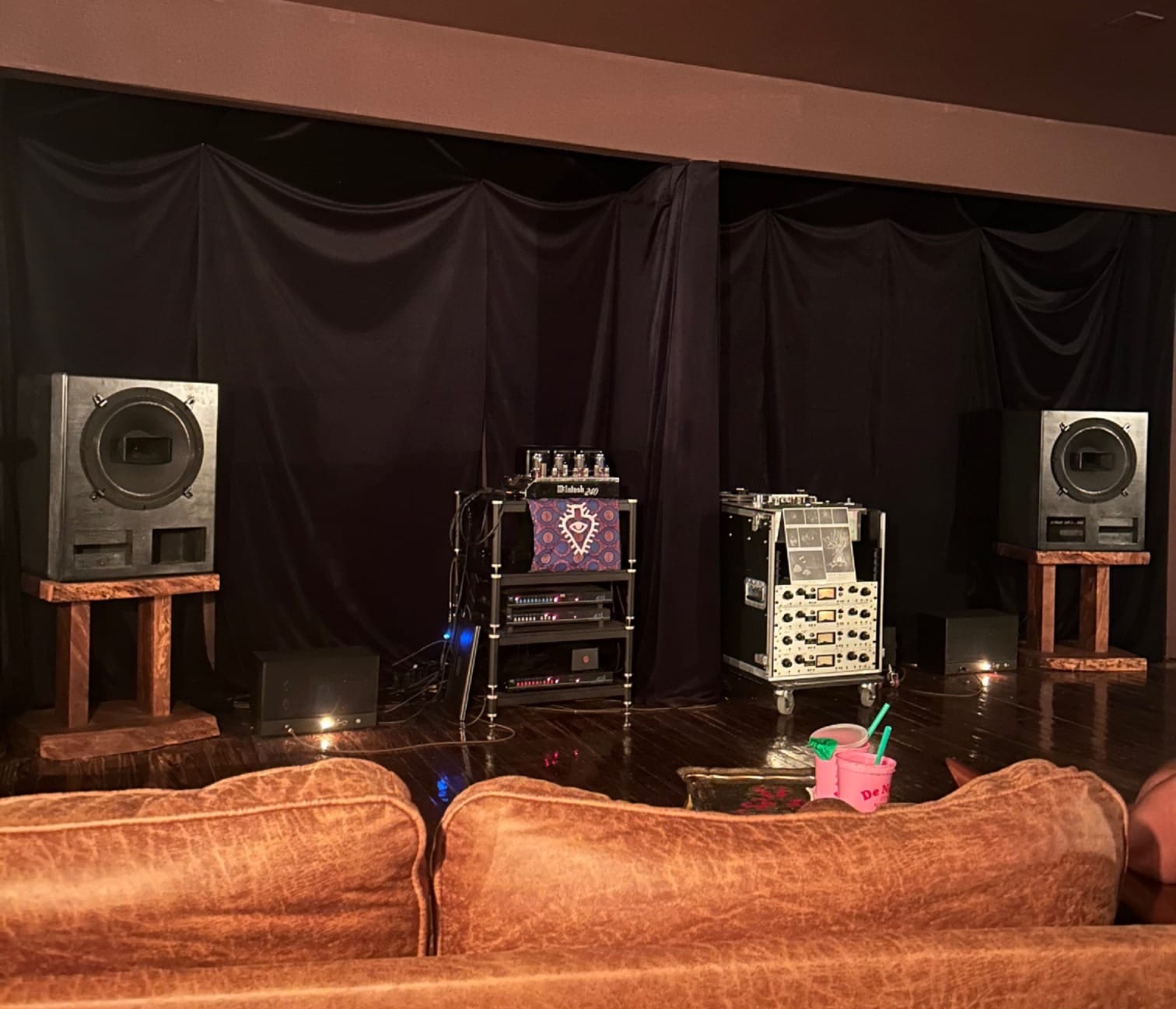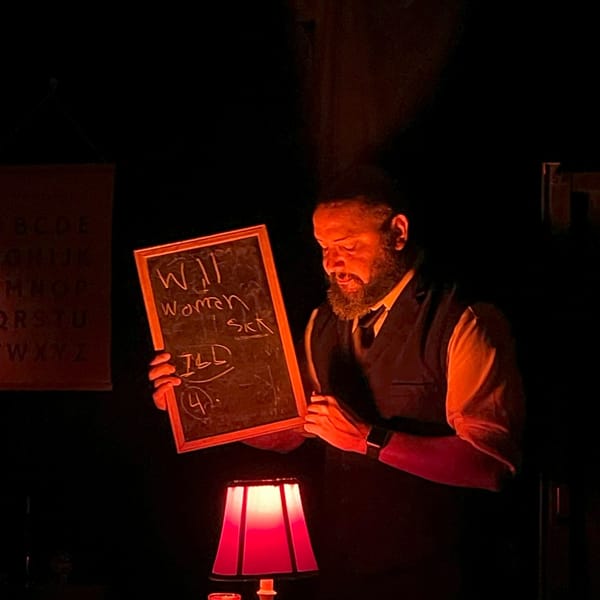Great World of Sound

"Don’t bother — it’s not worth it." A grinning but clearly agitated British man softly stormed out of the Equipment Room, "an intimate space that houses one of Austin’s most special record collections played on custom vintage hi-fi equipment" below Hotel Magdalena on the goofily-named Music Lane, which sits next to the evolving and notorious-due-to-bougieness South Congress street.
"Excuse me?" asked our hostess. The leaving man ignored us and we stepped inside, where the Brit’s two remaining companions argued with the bar staff. From our server later, I eked out information to the effect that the trio’s vaping, over-drinking, and loud conversation was starting to grate on the venue’s hospitality. And that — followed by the DJ's choice of the first sides of the well-trod The Miseducation of Lauryn Hill and a Gypsy King album — was our introduction to Austin’s blooming listening culture, a social experience that as its first principle relies on excellent stereo equipment, extremely deliberate listening choices, and, later, drink and food. The Equipment Room is an Austin response to the Japanese Jazz Kissa, and is a bit of a departure in a city obsessed with maintaining its status as the (self-proclaimed) live (not recorded) music capital of the world. Apparently not everyone is a fan.

The staff at the Equipment Room asks patrons to speak quietly, and serve what they call "snacks" (so don’t go in super-hungry). A group of well-dressed young women sat down at couches nearby, taking photos and photos of themselves. Another individual, not speaking quietly enough for me not to overhear, said that with a rooms like this one, Austin now rivaled New York, L.A. etc. (this got lots of nodding from his group). The man making these proclamations mentioned later that he was, in fact, an investor in the Equipment Room.
A desire to hear a loved album as expansively and as "good" as possible can lead in some disorienting directions. Reading passionate audiophile testimonials is a glimpse into a mirror-world of contradictory conclusions as to what vinyl pressings are worth listening to versus not. Let's visit Discogs, where opinions skew widely on, for just one example, the Luaka Bop release Who is William Onyeabor?
SongandDanceMan9 opines: “Great pressing. Such a great pressing in fact, that i'm actually going to call you a jackass if you dont pick this up.” poochierecords agrees, saying “All three of my LPs are dead quiet, which is sadly rare these days. Great comp, great pressing.” Dissenting opinions include a block of text from you_did_it, whose response I’ll include in full: “fantastic bullshit...referring to the original rough mix with them edges this compi sounds like an inbetween of singing a child into sleep n creamy gay-disco...transfering political | critical messages whenever packed in a easily understandable kind to follow them days of first issueing now this sounds belonglesness cheesy...not to understand me wrong: great artist n great music but only by them originals...better go for them n see.”
Label The Numero Group also inspires adoration and frustration for their releases. Filippo_morris calls out “Bad pressing quality ... but good music. Hope they can fix their quality issue,” and is seconded by farawaysounds, who says: “have stopped praising Numero Group for their digging and selecting skills. Because when they keep locating all this wonderful music, buying the repressing rights, and completely botching the vinyl pressing; they are actually just guaranteeing that no one else is going to scoop up this music and give it the vinyl pressing it deserves.” But a user named “literally” disagrees completely, even literally: “i have many vinyl releases from this label and have never had any issues with skipping or warping.”
So which is it? And remember, this isn’t even taking into account the hardware designed for listening to these off-kilter, noisy frisbees/quiet masterpieces. After all the talk about art as subjective, is the same also true for the science of sound?
To move away from vinyl and into streaming, Liz Pelly’s expose of Spotify, Mood Machine, locates something even more disorienting than poor pressing in that giant’s approach as a host for music — an inherent belief that what they’re selling is a kind of algorithmically trained sound fountain, meant in its ideal state to discourage active listening and reward a kind of sonic dissociation tuned to whatever broad, AI-bred or fake artist fodder meets the requirements of the moment (“Night Mix,” to give just one inane example).
Spotify co-founder Daniel Ek’s interest in music as a meaningful human endeavor that could make its creator money is significantly less than, in my reading of Pelly, a desire to coat every listenable minute of our lives in some playlist or other (the least arresting, the better) that shoots profits upward and away from skin-and-blood creators and to the stewards of the platform.
What Spotify’s competitors Tidal and others offer is not just more money for creators, but something meant to appeal to listeners as well — higher fidelity. Although I was happy to delete my Spotify account after years and years as a listener after reading Pelly’s book, I was less confident about what I would be hearing so differently through my headphones after moving to a new streaming service. And to return to the original subject of this piece: what is the best way to really hear recorded music?
A friend alerted me to another listening room she wanted to visit, and four of us ventured over to Terry’s Kissa (or Terry’s Hi-Fi Kissa), located very close to Central Machine Works on East Cesar Chavez. Unlike the Equipment Room’s positioning as a quasi-restaurant/bar, Terry’s place is literally a “wood-floored house” with the living room set up as a big listening station featuring quite a few mismatched chairs in two rows, and poised in front of very large speakers flanked on one side by Terry’s turntables and, behind that, a wall of records.
It’s BYOB, and our entry fee was only $20 a head for the whole night. We brought our own records for Terry to play, and, after arriving around 8, I had to push our crew out the door around midnight. What makes Terry’s Kissa so accommodating wasn’t just the set-up (the house is also filled with games and other separate, more intimate listening stations for those interested) but Marshall Terry himself, that rare breed of an intensely well-rounded listener with an expertise in equipment who is not only Not a Snob but an engaging and agreeable sort of person who, even if I were to bring in, say, Texercise on vinyl, would no doubt have something positive to say about my choice.

My favorite experience that evening was listening to a few songs from my friend Tim’s Coil record Musick to Play in the Dark Vol. 1 (Marshall’s MO is to play about one to three songs from each record he’s been given) and to experience the undulating synthesizers as expressed through, apparently, “classic Alnico based 604's and a restored McIntosh 240 tube amp.”
Having decided Marshall was both nice and knowledgeable, I decided to pepper him with a few important questions, starting with whether or not listening to vinyl really did offer more than another format. The answer was something along the lines of “yes, but.” [Note: the conversation below began in person, and Marshall later clarified certain points via email].
Terry begins at the beginning, with the musician’s recording. "The artist creates [the record], and the final mix is either on tape, or it’s on a digital file. If the digital copy is their polished creation, and that's exactly as they want it to be heard, there's a couple sites where you could download the WAV." Or, if you don't own the WAV (or .wav), you can stream them: "We can stream WAV files just fine. It just is problematic and data hungry when on a mobile hotspot — of course, while driving, or away from wifi, etc. A WAV file is not as gigantic as a 1080p movie. There isn't any excuse why it's not possible to offer WAV streaming."
"CDs are at 16 bit at a 44.1 kilohertz sample rate…Spotify's (usual rate) is even much less than that," says Terry. "It's like MP3-esque. But the best, what they call high-res now, is 24 bit, a much more detailed capture of the sound waveform, at 96,000 samples a second, if not more. They haven't been made as a FLAC or made at different bit rates. That kind of digital downsampling or 'shrinking' is detrimental, and its quality is subjective due to the streaming platform doing that manipulation, rather than a studio engineer."
"Vinyl gives all of us a nice excuse to have a record that isn't so squashed, most of the time."
"Ideally you could go download HD tracks or whatever, and get that .wav. And here's the caveat, which is that artists with their labels have this push to make records at a certain loudness, so a lot of times when they're doing an archive or a final mix — and the artist is there and they have it mastered — there's this extra step that they sometimes don't get to sign off on, which is this: extra loudness limiting. And that doesn't just make it loud. There's other artifacts that kind of go into the sonic field, and it's a whole art of people who do loudness limiting. So, vinyl gives all of us a nice excuse to have a record that isn't so squashed, most of the time."
"Sometimes the digital is a little compromised in other ways other than resolution, like, for instance, pushing digital files to be louder. Here's where vinyl can get the edge on a digital source: there's actually more limitations in making a vinyl record of squished up loud tracks. You actually have to cut records at a reduced level on the vinyl because of the way the groove is cut, and it either can't track the record, or you have to reduce bass. It's been the parlance these days that even for major releases — you can even say with a Lady Gaga record — they provide a copy of the master, whatever they signed off on, without the loudness limiting on the records."
"These are little lithographs that can be really cool."
Vinyl also provides a consumer advantage to more cash-strapped audiophiles. To get the best sound out of a vinyl setup, Terry says you could get "a $500 record player, a $500 needle, and a $500 preamp." Conversely, "the amount of digital technology to kind of match that is more at like the $3,000 or $4,000 level. So for the consumer, not only are you getting this kind of extended capability on the record, but for $1,500 and less, you ostensibly can get a cooler playback from it, and you support the artists with your dollar so much more with buying records in contrast to streaming."
What further impressed my group was that Terry was willing to not just tell, but show. I pulled out a copy of Queen’s Hot Space, requesting "Body Language," which my wife has a fondness for. He then played us two versions of the song: one, the digital remaster, which was cut for the label (and was the version I am familiar with) and another, original vinyl cut made to with the band at the time of its release.
"It's kind of cool that if the artist was there and the vinyl record was done at the same studio, it was done through the monitoring and the equipment that they signed off at, and you're getting a little screen print of how they heard it or signed off on with that particular equipment, in that country, on that power grid, and everything else," says Terry. "These are little lithographs that can be really cool."
The contrast between both versions of the song was significant. The more poppy, snappy version felt lightweight compared to the musky, bottom-heavy version he played for us next. How strange: the same producer, band and studio, but two divergent mixes that changed my perception of this song and made me wonder what other alternate mixes were lurking behind songs that I loved.
As listeners — either alone or in a crowd — our options for sonic fidelity are matched only by ways to protect our hearing. As technology has surpassed our expectations in making music available, so have the options to keep our hearing intact. Earplugs have always existed, but their ubiquity (or so I’ve noticed) and quality (so people tell me) has improved dramatically. There’s no need, if there ever was, to stick toilet paper in your ears to muffle the more painful decibels.
At the same time, our senses will fail us to a point that innovations in protecting our ears can only be palliative. Our hearing peaks in our late teens and early twenties (around the time I was listening to Turn On the Bright Lights at an evil volume) and starts to atrophy after 25. Hearing well, on the best equipment, to wonderful music, is — in the best way — a luxury, and listening itself has never been simple.
With recorded music, a person can get lost in factors both within and without our control: how the music was recorded, and mastered; what kind of hi-fi dream setup or busted-ass speaker we’re using to play it; how damaged or healthy the nerve cells in our ears may be; and even the shape of a room where music is made and heard.
Deliberate listening, even at its most pretentious and precious, signals an appreciation for the germ of sound that can become a piece of art, created by real people, best enjoyed in the presence of friends, and reasonably loud. Finally, if you don’t have the $3,000 dollars or $1,500 for your own home hi-fi? I recommend visiting Terry’s place for the evening — and make sure to ask about "Body Language."




